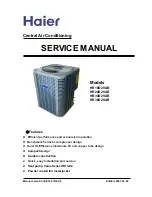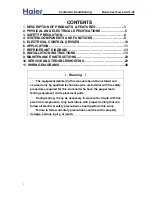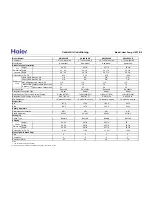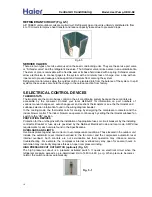
3.
SAFETY PRECAUTIONS
4.
SYSTEM COMPONENTS AND FUNCTIONS
This section describes the various air conditioning components, their purpose and operation. This
section is only a guide and does not consider all components that could be found on an air conditioner in
the field.
Fig.4-1
Generally, liquid refrigerant is suspected if valve damage occurs. Some compressors can tolerate the
gas gives it the name of “low-side” shell compressor
.
The scroll compressor used a helix (similar in shape to a snail shell)
within a similar stationary helix, the moving helix rotates so that the space between the two constantly
decreases as the gas moves toward the center of the Scrolls. The returning refrigerant gas first cools the
motor, then flows into the suction intake of the compressor scroll. The discharge gas leaves from the
center of the helix and exits the compressor. The lower part of the shell should be cool to the touch.
●
Follow the manufacturer’s instructions when making repairs, installing replacement parts and
●
Use only authorized factory parts.
●
Always use industry-recognized service practices in the maintenance, adjustment and repair of the
products covered in this manual.
●
Always wear safety glasses when handling refrigerant and peforming brazing operations.
CAUTION
:
please read all instructions prior to installing, operating, maintaining or repairing the
product.
WARNING: THE MANUFACTURER’S WARRANTY DOES NOT COVER DAMAGE TO CAUSED BY
THE USE OF ANSUTHORIZED COMPONENTS OR ACCESSORIES, THE USE OF SUCH
UNAUTHORIZED COMPONENTS OR ACCESSORIES MAY ENDANGER LIFE AND
OR INJURY RESULTING FROM THE USE OF SUCH UNAUTHORIZED COMPONENTS OR
PROPERTY. THE MANUFACTURER DISCLAIMS ANY RESPONSIBILITY FOR SUCH LOSS
ACCESSORIES
performing system maintenance.
Current single phase units use two types of compressors. The design of the two compressors types is
to move refrigerant. When paired
.
motor with low pressure
through proper refrigrant control. Returning refrigerant cools the compressor motor and surrounding the
presence of small amounts of liquid refrigerant in the return gas, but this condition must be avoided
are several different types of compressors, but all use electricity to turn an electric motor to drive a pump.
The heart of any refrigerant system is the compressor. It is a pump that causes refrigerant to flow. There
efficiency is reduced.
and low pressure sides of the system. If the valves are damaged, the compressor’s function and
down in cylinders where valves control the flow of refrigerant. The valves provide a seal between high
the driving force is supplied by an electric motor turning the crankshaft and forcing pistons up and
-sor. it operates with an offset crankshaft and pistons, and resembles an internal combustion engine.
Central air conditioners use two types of compressors. The first is the enhanced reciprocating compres-
time delays prevent thermostat short cycling and momentary power interruptions from damaging the
compressor.
-case heaters. The reciprocating compressor may need both. Both types benefit from using a time-delay.
quite different. But they function the same way. Scroll units do not need start components or crank
COMPRESSORS (Fig. 4-1)
8
Central Air Conditi
oning
Model: Heat Pump,
HR13-D2
Reciprocating type compressor for HR18/24
Reciprocating type compressor for HR30/36
f
f









































